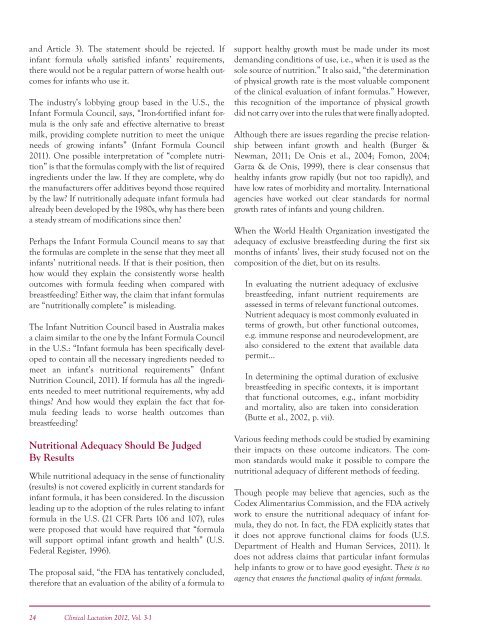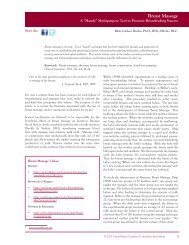Official Journal of the United States Lactation ... - Clinical Lactation
Official Journal of the United States Lactation ... - Clinical Lactation
Official Journal of the United States Lactation ... - Clinical Lactation
You also want an ePaper? Increase the reach of your titles
YUMPU automatically turns print PDFs into web optimized ePapers that Google loves.
and Article 3). The statement should be rejected. If<br />
infant formula wholly satisfied infants’ requirements,<br />
<strong>the</strong>re would not be a regular pattern <strong>of</strong> worse health outcomes<br />
for infants who use it.<br />
The industry’s lobbying group based in <strong>the</strong> U.S., <strong>the</strong><br />
Infant Formula Council, says, “Iron-fortified infant formula<br />
is <strong>the</strong> only safe and effective alternative to breast<br />
milk, providing complete nutrition to meet <strong>the</strong> unique<br />
needs <strong>of</strong> growing infants” (Infant Formula Council<br />
2011). One possible interpretation <strong>of</strong> “complete nutrition”<br />
is that <strong>the</strong> formulas comply with <strong>the</strong> list <strong>of</strong> required<br />
ingredients under <strong>the</strong> law. If <strong>the</strong>y are complete, why do<br />
<strong>the</strong> manufacturers <strong>of</strong>fer additives beyond those required<br />
by <strong>the</strong> law If nutritionally adequate infant formula had<br />
already been developed by <strong>the</strong> 1980s, why has <strong>the</strong>re been<br />
a steady stream <strong>of</strong> modifications since <strong>the</strong>n<br />
Perhaps <strong>the</strong> Infant Formula Council means to say that<br />
<strong>the</strong> formulas are complete in <strong>the</strong> sense that <strong>the</strong>y meet all<br />
infants’ nutritional needs. If that is <strong>the</strong>ir position, <strong>the</strong>n<br />
how would <strong>the</strong>y explain <strong>the</strong> consistently worse health<br />
outcomes with formula feeding when compared with<br />
breastfeeding Ei<strong>the</strong>r way, <strong>the</strong> claim that infant formulas<br />
are “nutritionally complete” is misleading.<br />
The Infant Nutrition Council based in Australia makes<br />
a claim similar to <strong>the</strong> one by <strong>the</strong> Infant Formula Council<br />
in <strong>the</strong> U.S.: “Infant formula has been specifically developed<br />
to contain all <strong>the</strong> necessary ingredients needed to<br />
meet an infant’s nutritional requirements” (Infant<br />
Nutrition Council, 2011). If formula has all <strong>the</strong> ingredients<br />
needed to meet nutritional requirements, why add<br />
things And how would <strong>the</strong>y explain <strong>the</strong> fact that formula<br />
feeding leads to worse health outcomes than<br />
breastfeeding<br />
Nutritional Adequacy Should Be Judged<br />
By Results<br />
While nutritional adequacy in <strong>the</strong> sense <strong>of</strong> functionality<br />
(results) is not covered explicitly in current standards for<br />
infant formula, it has been considered. In <strong>the</strong> discussion<br />
leading up to <strong>the</strong> adoption <strong>of</strong> <strong>the</strong> rules relating to infant<br />
formula in <strong>the</strong> U.S. (21 CFR Parts 106 and 107), rules<br />
were proposed that would have required that “formula<br />
will support optimal infant growth and health” (U.S.<br />
Federal Register, 1996).<br />
The proposal said, “<strong>the</strong> FDA has tentatively concluded,<br />
<strong>the</strong>refore that an evaluation <strong>of</strong> <strong>the</strong> ability <strong>of</strong> a formula to<br />
support healthy growth must be made under its most<br />
demanding conditions <strong>of</strong> use, i.e., when it is used as <strong>the</strong><br />
sole source <strong>of</strong> nutrition.” It also said, “<strong>the</strong> determination<br />
<strong>of</strong> physical growth rate is <strong>the</strong> most valuable component<br />
<strong>of</strong> <strong>the</strong> clinical evaluation <strong>of</strong> infant formulas.” However,<br />
this recognition <strong>of</strong> <strong>the</strong> importance <strong>of</strong> physical growth<br />
did not carry over into <strong>the</strong> rules that were finally adopted.<br />
Although <strong>the</strong>re are issues regarding <strong>the</strong> precise relationship<br />
between infant growth and health (Burger &<br />
Newman, 2011; De Onis et al., 2004; Fomon, 2004;<br />
Garza & de Onis, 1999), <strong>the</strong>re is clear consensus that<br />
healthy infants grow rapidly (but not too rapidly), and<br />
have low rates <strong>of</strong> morbidity and mortality. International<br />
agencies have worked out clear standards for normal<br />
growth rates <strong>of</strong> infants and young children.<br />
When <strong>the</strong> World Health Organization investigated <strong>the</strong><br />
adequacy <strong>of</strong> exclusive breastfeeding during <strong>the</strong> first six<br />
months <strong>of</strong> infants’ lives, <strong>the</strong>ir study focused not on <strong>the</strong><br />
composition <strong>of</strong> <strong>the</strong> diet, but on its results.<br />
In evaluating <strong>the</strong> nutrient adequacy <strong>of</strong> exclusive<br />
breastfeeding, infant nutrient requirements are<br />
assessed in terms <strong>of</strong> relevant functional outcomes.<br />
Nutrient adequacy is most commonly evaluated in<br />
terms <strong>of</strong> growth, but o<strong>the</strong>r functional outcomes,<br />
e.g. immune response and neurodevelopment, are<br />
also considered to <strong>the</strong> extent that available data<br />
permit...<br />
In determining <strong>the</strong> optimal duration <strong>of</strong> exclusive<br />
breastfeeding in specific contexts, it is important<br />
that functional outcomes, e.g., infant morbidity<br />
and mortality, also are taken into consideration<br />
(Butte et al., 2002, p. vii).<br />
Various feeding methods could be studied by examining<br />
<strong>the</strong>ir impacts on <strong>the</strong>se outcome indicators. The common<br />
standards would make it possible to compare <strong>the</strong><br />
nutritional adequacy <strong>of</strong> different methods <strong>of</strong> feeding.<br />
Though people may believe that agencies, such as <strong>the</strong><br />
Codex Alimentarius Commission, and <strong>the</strong> FDA actively<br />
work to ensure <strong>the</strong> nutritional adequacy <strong>of</strong> infant formula,<br />
<strong>the</strong>y do not. In fact, <strong>the</strong> FDA explicitly states that<br />
it does not approve functional claims for foods (U.S.<br />
Department <strong>of</strong> Health and Human Services, 2011). It<br />
does not address claims that particular infant formulas<br />
help infants to grow or to have good eyesight. There is no<br />
agency that ensures <strong>the</strong> functional quality <strong>of</strong> infant formula.<br />
24 <strong>Clinical</strong> <strong>Lactation</strong> 2012, Vol. 3-1




